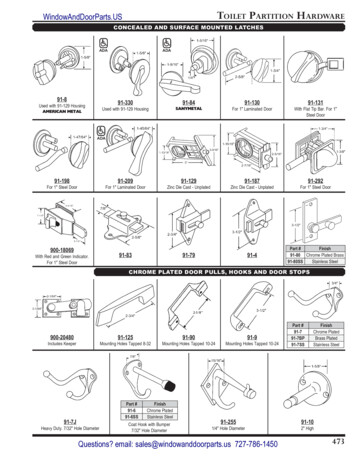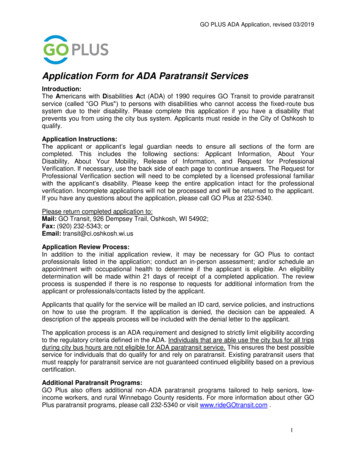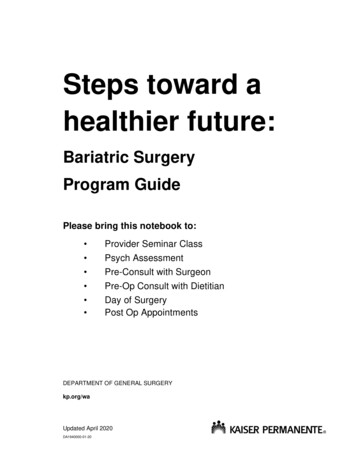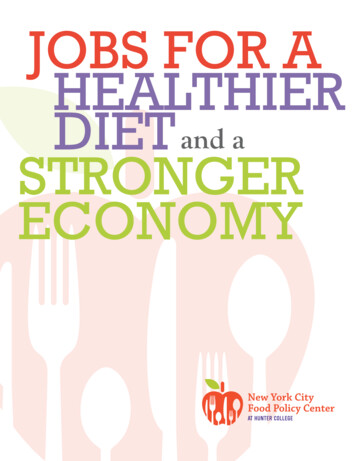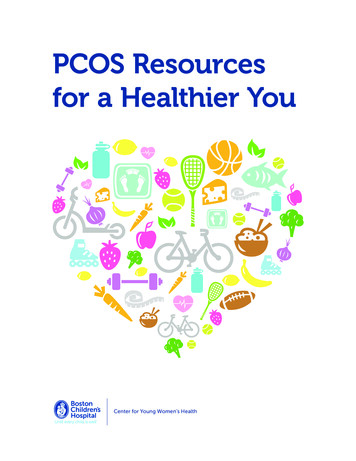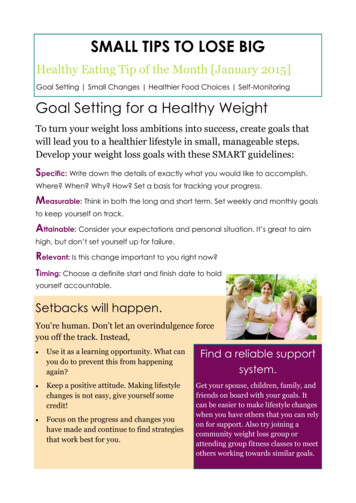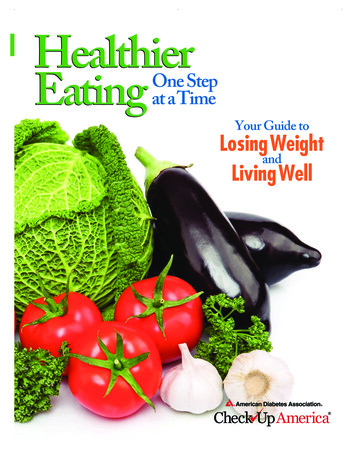
Transcription
ADA Healthier Eating 10/25/11 11:18 PM Page iHealthierOne StepEating at aTimeYour Guide toLosingWeightandLivingWell
ADA Healthier Eating 10/25/11 11:18 PM Page iiHealthierOne StepEating at aTimeYour Guide toLosingWeight and LivingWellAre you ready to lose weight and improveyour health, fitness, and energy?Being overweight can do a lot to hurt your health. It canraise your risk for diseases like diabetes, heart disease,and some cancers. If you already have diabetes, it canmake your disease harder to control, raising your riskfor complications.CONTENTSBut you can lower your risk for these problemsby losing weight. Losing just 10 to 15 poundscan make a big difference in your health. Thereare many ways to lose weight, and you don’thave to do it all at once. Make a realistic, achiev able plan and take it slowly. You can do it!Lower Fat Eating .3Make a Plan.6Eating on the Road.8Controlling Calories.10Create Your Plate .18
ADA Healthier Eating 10/25/11 11:18 PM Page 1Your Weight & Your HealthHow do you feel about your weight? Are youcomfortable with the way your body works, looks andfeels? Or do you sometimes think: I need to lose weight. I don’t have the energy I would like to have. I feel that my weight is holding me back fromthings I want to do. I would like to look and feel healthier. I would like to manage my diabetes or prediabetesbetter, and losing weight would help. I want to stay healthy and prevent type 2 diabetes.If so, you are not alone.The Many Options for Weight LossThere are many ways to lose weight, and there is noone perfect fit for everyone. But one thing is true nomatter who you are: If you want to lose pounds, youmust eat fewer calories than your body burns off.How you achieve this is up to you.This brochure focuses on healthy eating for weightloss. A balanced, healthy diet is the best way to loseweight and keep it off. For some people, this maymean cutting back on highly processed foods likecookies, chips, and soda. For others, a low fat dietthat contains lots of fruits, vegetables and whole grainsmay be the answer. Sometimes, meal replacementslike a shake or bar for breakfast or lunch may be help ful in losing weight. For most people, adding physicalactivity to their daily routine is also important.Only you can decide what the best choice is for youbased on your lifestyle and food preferences.Thisbooklet can help you set goals and make a plan tolose weight.A healthier tomorrowis within your grasp!If you want to lose pounds, you musteat fewer calories than your body burns off.1
ADA Healthier Eating 10/25/11 11:18 PM Page 2Meet LauraLaura is a 38 year old single mother of two. With afull time job and two kids in school, her day ispacked, making it difficult to find time to exercise.Laura feels she has no time to cook so she and herfamily often grab meals on the run.“I want to eat healthy, and I want togive my kids food that is good forthem. But my day is so busy! Afterwork and school, the kids have soccerpractice or piano lessons or Scoutmeetings, and they are always hungrybefore they go. Sometimes I feel likethe only option is a drive thru, but Iknow that’s not the best food forevery day.”Laura has just been diagnosed with polycystic ovarysyndrome (PCOS). Insulin resistance and diabetesare problems that can come with PCOS. Right nowLaura weighs 160 pounds. Her doctor recommendsNo time to cook?It is easier to control what you eat when you cookyour own meals, because you know what you putinto every dish. But this can be hard to do on busydays. If this is the case for you, try these ideas: When you do have time to cook, like on theweekend, prepare extra portions of healthymeals.» Freeze the leftovers for a busy day.» Find healthy recipes on My Food Advisor, ADA’s online tool that can help you makesmart food choices. Check it out atwww.diabetes.org/myfoodadvisor Pack healthy snacks ahead of time that areeasy to eat on the run.2she lose at least 7% percent of her weight, which isabout 12 pounds.Healthy weight loss is about 1 or 2 pounds a week.Laura’s goal is to lose 12 pounds in 3 months.Breaking it down into smaller pieces makes it feelmore achievable, so Laura concentrates on 4 poundsevery month, or just about one pound a week.Laura visited a registered dietitian (RD) who helpedher get started. The RD asked Laura to keep a foodand exercise log to track the changes she makes andhow the changes work out for her. Keeping a log, likethe one on page 7, is a good way for Laura to seewhat she actually eats and does in a day. Then, shecan use this to decide what she would like to change.» Vegetable sticks, whole fruit, reduced fatcheese cubes, whole wheat crackers, and singleservings of yogurt or canned fruit are goodchoices. Make smart fast food choices.» Choose salads, fruit, and low fat milk.» Choose leanmeats that arebaked or grilledinstead of frieditems.» Plan ahead andcheck caloriecounts, whichshould beavailable in the restaurant or on their website.
ADA Healthier Eating 10/25/11 11:18 PM Page 3What about other health problems?There are some medical problems that can make itharder to lose weight. Laura has PCOS, which meansher body doesn’t use insulin as well as it should, andshe is more likely to gain extra weight. PCOS alsomakes her more likely to develop other health prob lems like type 2 diabetes and heart disease.If you have a condition that might make it moredifficult for you to lose weight, talk with your doctorabout your options. A registered dietitian can helpyou make eating and exercise plans that are realisticand achievable for you. Use nonstick pans and cooking sprays instead ofadding fat. Boost the flavor of foods with seasonings and low fat sauces. Look for recipes that use herbs andspices for flavor instead of fat. Squeeze fresh lemon juice on steamed vegetables,broiled fish, rice, or pasta. Try lemon pepper or mesquite seasoning onchicken. Use onion and garlic to liven up meats andvegetables.Lower Fat EatingYou can protect your heart and blood vessels byeating less saturated fat and trans fat. Cutting downon fat can also help with weight loss. The food youeat and the way you cook can make a big difference.Try these tips:Cook with less fat. Eating lower fat foods doesn’tmean you have to give up flavor. Making somesimple changes to the way you cook or order yourfood can make a big difference: Try broiling, microwaving, baking, roasting,steaming, or grilling foods. Avoid frying foods in the kitchen.Can I prevent type 2 diabetes?Yes, you may be able to delay or prevent type 2diabetes. Studies have shown that even a smallweight loss, like 10 to 15 pounds, can help. Youcan do this by: Eating a low fat diet with fewer calories. Being active about 30 minutes every day.These 30 minutes don’t have to be completedin one session; you can break it up into three10 minute sessions. Try baking chicken or pork with barbecue sauce orany low fat marinade or salad dressing. Make soups a day ahead so you can chill them andthen remove any fat that has risen to the top.3
ADA Healthier Eating 10/25/11 11:18 PM Page 4It is very important to be confident—believe that you can change.Choose vegetable sources of protein, fish andlean cuts of meat and poultry. Include vegetarian protein such as beans, tofu or aveggie burger a few times a week instead of meats. Choose fish at least two times a week. Choose poultry such as chicken, turkey, or Cornishhen without the skin (white breast meat is lower infat than the darker meat in the thigh and legpieces).Choose low fat dairy products. For milk, choose fat free (skim), 1/2%, 1% milk,low fat buttermilk, or soy milk. Choose low fat or fat free yogurt. For cheese, choose cottage cheese or any cheesewith 3 grams of fat or less per ounce. For a frozen treat, try low fat ice cream or frozenyogurt. You can also freeze regular yogurt for atreat. Choose lean cuts of beef such as round, sirloin, andflank steak; tenderloin; rib, chuck, or rump roast;T bone, porterhouse, or cubed steak.Substitute lower fat ingredients in your favoriterecipes. Lean types of pork include ham, Canadian bacon,pork loin, and center loin chops. Try extra lean ground beef or ground turkeyinstead of regular ground beef. Cut away visible fat from meats. Use light or reduced fat mayonnaise and saladdressings instead of regular. Roast meats on a rack and let the fat drip off. Try plain yogurt in place of sour cream ormayonnaise. Substitute up to half the margarine or butter insome recipes with applesauce.“I talked to my doctor about losingweight, and she suggested I take smallsteps to change my eating and myactivity habits. She said small changescould help me lose weight andimprove my health. So, I’m going topick one or two things I know I canchange, and work on those. One goalwill focus on healthy eating and theother on physical activity. When thoseare part of my new lifestyle, I’ll addanother change.”4
ADA Healthier Eating 10/25/11 11:18 PM Page 5Small Steps for Your HealthAre you ready, willing, and able tochange?Every change involves several stages, and each stage isimportant. For Laura, the stages went like this:To succeed at making lifestyle changes you need toanswer YES to the question: are you ready, willing,Stage 1and able to change? The experts say that for people toLaura decided she wanted to lose some weight.change, making the change must be important toStage 2them. You have to have good reasons to change. Forexample, you want to live long enough to see yourShe thought about ways she could cut calories andgrandchildren grow up. It helps to have more reasonsexercise more. She decided she wasn’t ready to tryto change than reasons not to change. The expertsevery idea. But for some, she was ready.also say that it is very important to be confident—Stage 3believe that you can change.At the time, she ate ice cream almost every night as asnack. She knew that replacing ice cream with some Answer the following questions to see whetherthing lower in calories and fat might help her loseyou are ready, willing, and able to change.weight. She also looked at her schedule to find time1. What’s my reason for making a change?to add some physical activity to her routine. Shedecided that she could probably fit in a 25 minutewalk during her lunch hour.2. Am I ready to make a change?These were both changes that she was willing and1 2 3 4 5 6 7 8 9 10able to make. She saved changes she wasn’t ready toNotMaybeYes,make until another time.at alllet’s go!Stage 4Next, Laura made a realisticplan. She’d have an appleinstead of ice cream at least 4times a week. She would alsogo for a 25 minute walk everyday of the work week duringlunch.Stage 5Then, she took action. She bought some apples andstarted bringing her walking shoes to work every day.3. Am I willing to make a change?1 2 3 4 5 6 7 8 9 10Notat allMaybeYes,let’s go!4. Am I able to make a change?1 2 3 4 5 6 7 8 9 10Notat allMaybeYes,let’s go!5. Am I confident I can make a change?1 2 3 4 5 6 7 8 9 10Notat allMaybeYes,let’s go!5
ADA Healthier Eating 10/25/11 11:18 PM Page 6Start setting goals and making a plan.Make a PlanThis might get in the way of my plan:Once you’ve decided you’re ready, it’s time to setgoals and make a plan. Think of 1 or 2 things you arewilling to change. Set a goal for each. Think about afew things when you set goals:Example: I might need a pick me up on a night thatI usually eat an apple and have ice cream instead.Example: I might not have time to take a lunch breakone day of the week. How often will you do this? What behavior will you change? Be specific.If that happens, I’ll do this instead: Don’t try to change too much at once. Be realistic.Example: I’ll plan to eat an apple another day laterthat week so I still reach my goal.Example: I’ll take a walk with a family member afterdinner that night instead.Some examples of goals that follow these guidelines:Eating: Four days each week (how often) I will eatan apple instead of ice cream as my evening snack(realistic and specific).Physical activity: Five days each week (how often)I will take a 25 minute walk during lunch since Idon’t really need the whole hour to eat (realistic andspecific).Notice that the eating goals are not “I will eat morefruit” or “I will eat healthier.” The activity goal is not“I’ll walk more.” Goals like that are not specificenough.Set your goals. Try writing a few of your own goals:There are also some other things that youshould plan for:Here’s what I need to get ready:Example: I need to go to the grocery store and buyapples.Example: I need to start packing my walking shoesfor work every day.6Here’s when I’ll start:Example: I’ll start working toward both my goals nextMonday.Food & Activity TrackerKeeping track of your food, drink, and activity canhelp you lose weight and stay active. For a week ortwo, measure your serving sizes. Write down every thing you eat and drink and the activity you do.Use the sample trackers on the next page to getstarted. Make a similar journal in a notebook andkeep it with you.Then, review your food and activity trackers to learnmore about your food and activity habits. Maybe youdidn’t realize that your ice cream servings are reallytwo servings, or that you’re walking twice as far asyou thought you were. Use this information to makea plan.
ADA Healthier Eating 10/25/11 11:18 PM Page 7Daily Food & Drink TrackerDate and TimeFood/Beverage Consumed,including quantitySocial ContextCommentsMonday7 amMonday9 am2 blueberry pancakes with maple syrup,2 strips of bacon, coffee with creamDoughnut andcoffee with creamAlonebefore workWithcoworkersAlways very hungry in the morning, butfeel too full when finished.Don’t really want to eat, but wanted abreak and someone brought doughnuts.Daily Activity TrackerDate and TimeLocationActivitySocial ContextCommentsMonday 6 pmTuesday 4 pmHomeWork1 mile walkJazzerciseAlone after workWith coworkersI get bored walking alone.I like socializing while I exercise.A good way to track your activity is by wearing apedometer. A pedometer is a small machine that youcan clip to your belt to track your steps. Use one tofind out how active you are now. Write down your totalsteps each day and use it to set an activity goal.7
ADA Healthier Eating 10/25/11 11:18 PM Page 8Meet AmgadAmgad is a 53 year old businessman who travels alot for his job. He doesn’t always have a lot of choicesin what he eats or does. He dines out a lot and some times he can’t find healthy foods at the airport. A lotof times, he has to depend on the food provided inmeetings for his meals. Sometimes choices includehealthy items, like fruits, vegetables, and whole grainbreads but sometimes the only options are high fatpastries and doughnuts.“My busy days also make it hard tofind time and places to exercise, andnot all hotels have exercise rooms.”Amgad has noticed his weight creeping up and hehas gained nearly 20 pounds over the years. He wantsto lose some weight and have more energy so he cankeep up with work and be there for his family. Hehas decided to make some changes that will improvehis health.Amgad is 5’ 10’’ and weighs 200 pounds. His doctortold him that his BMI is about 27. Amgad sets a goalto lose about 16 pounds to get into the healthy range.He can do this by eating healthier on the road and byfinding ways to fit physical activity into his schedule.Eating on the RoadFrequent travelers are often limited to what they canfind in airports and restaurants, so eating healthy canbe difficult. Here are some tips that can help:Body Mass IndexIf your BMI is you are: Pack your ownsnacks. Keep a smallbag of nuts, driedfruit, or trail mix withyou when you travel.When the urge forcheese fries hits, eatyour snack instead.Under 19Underweight Choose water in airport shops and on the plane.More than 19 but less than 25Healthy weightMore than 25 but less than 30Overweight If your flight includes a layover, pick up a piece offresh fruit, an energy bar, or a bottle of low sodiumvegetable juice for the flight.More than 30ObeseYour Body Mass Index (BMI) is a measure of yourheight and weight. It can give you an idea of ahealthy weight range for you. Find out your BMI atwww.diabetes.org/bmi.BMI Ranges Watch out for the free breakfast and other mealsoffered at some hotels and meetings.» Limit yourself to one trip up to the buffet orbreakfast bar.8
ADA Healthier Eating 10/25/11 11:18 PM Page 9Exercising While On The RoadAmgad has decided to try a popular weight lossprogram. It is offered at his office, so he signed upand has the support of his colleagues. This programassigns a point value to each food, and participants tryto stay within a certain point range each day. Theprogram also has an online component which helpsto keep Amgad on track while he is on the road.This kind of plan makes it easier for Amgad tohandle an unpredictable eating schedule. For exam ple, if he is trapped in an airport with only pizza forlunch, he can count the value of a slice and plan tocut back a bit at dinner.» Skip the pastries, and go for a mix of protein,carbohydrates, and fresh fruit to keep you goinguntil lunch. Some choices include vegetableomelets, yogurt with granola and fruit, or oatmealwith nuts and raisins or dried cranberries.» If you’re in a pinch, make the best of what youhave. Even at a continental breakfast you canoften find half of a whole wheat bagel with low fat cream cheese and some fresh fruit. In restaurants, ask if meats can be grilled instead offried, and ask for sauces and dressings on the side.» Remember to choose fruit, salad, or othervegetables as side items, rather than french fries.» Order a salad or soup to start and then share anentrée.» Skip the appetizer and dessert.» Go easy on high calorie alcoholic drinks.Amgad can also find ways to fit exercise into his dayby varying his routine. Some hotels have weightrooms or swimming pools.Some have walking trailsnearby. Some days,Amgad may want to walkaround the airport during alayover.To make it easier to meethis exercise goals, Amgadmet with a trainer at thegym near his house andgot help putting together asimple routine that willtravel well. His trainersuggested walking forconditioning and gave himexercises using easily packed resistance bandsand his own body weightto build strength and flexi bility. Amgad can walkand do these exercises anywhere. If his hotel hasother facilities, he can use those to vary his routine.9
ADA Healthier Eating 10/25/11 11:18 PM Page 10Meet BethanyBethany is a 25 year old single woman with a job inadvertising that often has her working late or attend ing industry parties. When she is not working, sheloves going out to dinner or dancing with friends.“I love my job and my life, but sincecollege, I haven’t had as much time toexercise as I used to. I’m also temptedto eat too much when I have to worklate or attend parties with trays offinger foods. I’ve picked up a fewpounds, and I want to lose them. Iknow I need to start eating healthier Aerobic exercise includes walking, jogging, biking,and exercising again.dancing, or other things that get your heart rate up.”Bethany would like to lose about ten pounds. Sheloves to try new things, though her schedule doesn’talways give her a lot of free time. She has decided totrack her food and activity using logs like the onesfound on page 7. This will help Bethany see whereextra calories are sneaking into her diet. It will alsohelp her find a time that works best to fit physicalactivity into her schedule.Fitting in ExerciseBethany’s schedule is full, so when she thinks aboutadding exercise, she needs to make it part of her dailylife rather than a separate commitment. There arefour main types of exercise: Activity through the day includes walking insteadof driving, parking at the far end of the parking lot,taking the stairs instead of the elevator, yard work,washing the car, cleaning house, and playing withthe kids. A great place to start is to add 2,000 stepsto what you already do, which you can measureusing a pedometer. Gradually work up to as manysteps as you can take in day. Your long term goalcan be 10,000 steps through the day.10Everyone should try for at least 30 minutes ofmoderate activity (hard enough so you break asweat), five days a week. Strength training, likeweight lifting, usingexercise bands, or otheractivities to build andkeep muscle. Everyoneshould aim for threesessions a week. Stretching, like yoga or tai chi. Stretch as often asyou can.Bethany knows she needs to find time for each typeof exercise every week.Controlling CaloriesIt is easy to eat too many calories, especially whenothers are preparing the food, like in restaurants andat parties. But it is possible to cut calories and stillenjoy yourself: Alcoholic beverages can be very high in calories.Bethany can cut some calories by limiting herdrinks, alternating alcoholic drinks with sparklingwater or club soda, or opting for lower caloriechoices like spritzers or light beer.
ADA Healthier Eating 10/25/11 11:18 PM Page 11Choosing Activities for Good HealthWays To Cut at Least 100 CaloriesTrying new activities can be a good way to keep ahealthy weight. Recreation centers, parks, andcommunity colleges are good places to try a newhobby or activity. Do you drink more than 2 glasses of whole or2% milk per day? Switch to 1% or low fat milkBethany decided to start by adding just 10 minutesof exercise to each day, something she can easilydo during the commercial breaks in her favoritetelevision shows. She added stretching, handweights, and walking in place during these breaks.While she didn’t expect this would make a majordifference, she found that she liked it so much sheadded more time to her exercise routines and haseven joined a gym. Limit meat portions to 3 to 4 ounces (about thesize of a deck of cards)She also found some friends who want to becomemore active. They started attending spinningclasses together at the gym one night a weekinstead of going to happy hour. They also take along walk together on weekends. Appetizer trays often have both high and low calorie foods. Bethany can make smart choices atparties by snacking on raw veggies or fruit andwhole grain crackers, instead of creamy dips andchips. In restaurants, Bethany can cut calories by choosingsalad or a broth based soup rather than nachos orfried appetizers. She can also split an entrée with afriend or ask the kitchen to box up half of her mealso she can take it for lunch the next day. Bethany can bring snacksand a lunch to workrather than buyingfast food. Skip the sugary coffee drinks, and order regularcoffee with low fat milk and a sugar substitute Drink diet soda instead of regular soda Switch from cooking with butter, margarine, oroil to a cooking spray When making sandwiches or burgers, skip thecheese Instead of a regular or king size chocolate bar,savor a fun sized one Don’t reach for that second glass of wine orother alcoholic drink Split dessert with 2 or 3 friends Eat an apple or a 6 ozcup of light yogurt for asnack instead of a candybar or ice cream Choose a small order offrench fries instead of alarge Use a measuring cup to check your portion sizes Choose marinara sauce instead of creamy whitesauce Use milk instead of cream in mashed potatoesand sauces Do you have other ideas for small changes youcan make to save on calories? Write them here:11
ADA Healthier Eating 10/25/11 11:18 PM Page 12Meet LarryLarry is a 45 year old man who has high bloodpressure and type 2 diabetes. His BMI is 36, so hefalls into the obese category (see page 8 for moreinformation on BMI). To help him manage hisdiabetes and lower his blood pressure, Larry hasdecided to lose weight.Although he would like to lose a lot of weight, heknows that even a few pounds can improve hishealth. His doctor told him to set a realistic, achiev able goal. It took Larry many years to put on the extraweight, and it’s going to take some time to lose it.Larry has set a goal of losing 15 pounds over the nextthree months.“As the pounds crept on over theyears, I found myself being less andless active, even giving up some of theoutdoor activities I enjoyed. On topof that, I was eating more for noapparent reason. It has turned into avicious cycle. Now, I want to get backto a healthy weight that lets me dothe things I like.”Larry’s situation is complicated by many years ofcarrying extra weight, which have taken a toll on hiships and knees, making exercise painful. Once heloses weight, Larry will look into knee replacementsurgery.StartingExercise SlowlyLarry needs to doexercises that areless stressful on hisjoints. Larry joinedthe YMCA near hishouse and signed upwith a trainer to getstarted. Larry’strainer hassuggested anarmchair exerciseroutine. He also toldLarry he could try water walking and chair yogaclasses at the gym. As he grows stronger, he may beable to move to other activities.12
ADA Healthier Eating 10/25/11 11:18 PM Page 13Meal ReplacementsUnder his doctor’s supervision, Larry is going to try ameal replacement plan to lose weight. Meal replace ments are a pre packaged shake, bar, or main dishthat take the place of one or more of your meals.They have a set number of calories which helps totake some of the guesswork out of planning a meal.Larry decided to use a meal replacement for breakfastevery morning to start. His doctor told him that as heeats less and loses weight, he will need to makechanges to his medicines. They set up an appoint ment in 1 month to see how things are going.Because Larry has diabetes, his doctor also recom mended he learn more about managing diabetes andhealthy eating by going to diabetes education classes.What is bariatric surgery?Bariatric surgery is weight loss surgery that helps aperson eat less and lose weight. Bariatric surgeriesare only for people with a BMI greater than 40 orfor some people with a BMI over 35 who have notbeen able to lose weight with other plans.There are two main types of bariatric surgery: Gastric bypass surgery makes the stomachsmaller by cutting off a small pouch of stomachand attaching the small intestine to this pouch.Because the stomach is smaller and food entersthe small intestine later, patients feel full soonerand absorb fewer calories from the food they eat.This change is permanent. Adjustable gastric banding places a bandaround the stomach to create a small pouch.Food enters the small pouch and takes a longertime to trickle into the rest of the stomach.Patients feel full sooner. Also, doctors can adjustthe band as the patient loses weight and needsmore or fewer calories. This change can bereversed if needed.Opting for bariatric surgery is a big decision. Talkwith your doctor about whether you might be agood candidate for surgery. If it is an option foryou, your doctor will help you decide which typeof surgery you need and what you need to dobefore and after the surgery to be successful.What about weight loss medicines?Some seriously overweight people may benefit from using weight loss medicines. There are a few optionsapproved by the FDA. One medicine works to prevent your body from absorbing some of the fat you eatand can be used for up to one year. There are also other medicines available that have been approved forshorter term use (12 weeks or less).Talk with your doctor about whether one of these weight loss medicines might be right for you. However,remember medication does not replace the need for healthy eating and physical activity.13
ADA Healthier Eating 10/25/11 11:18 PM Page 14Other Weight Loss ToolsThe Hunger ScaleThere are many things that tell us it is time to eat(other than a rumbling stomach): television ads,social events, smells from the food court, and thecandy bowl at the office. These factors in the envi ronment trigger our senses and other mentalprocesses that make us think we are hungry evenwhen we’re not.The Hunger Satiety Rating Scale below can help youdecide if you are experiencing real hunger.Too often however, we find food in front of us whenwe are above level 6 on the scale. Before you indulge,take a step back and think about how you feel. Didyou just eat a few minutes ago?Tracking your food intake may also help. Writedown how you feel at the time, and if you are eatingbecause you are hungry or if you are eating for otherreasons (perhaps because the food just happens to bethere, you don’t want to pass up a good deal, or youare eating in response to an emotion).How does the scale work?Before you eat, take a moment to rate your hunger.Think about how hungry you physically feel. Your goalis to eat between level 4 and level 6, so you are eatingwhen you are hungry but stopping when you arecomfortably full. But do not put off eating for too long.Waiting until level 1 or 2—when you are starving andunable to concentrate—may lead to overeating.Hunger Satiety Rating Scale10 9 8 7 6 Neutral 5 4 3 2 Hungry 1 Full14Stuffed to the point of feeling sickVery uncomfortably full, need to loosen your beltUncomfortably full, feel stuffedVery full, feel as if you have overeatenComfortably full, satisfiedComfortable, neither hungry nor fullBeginning signals of hungerHungry, ready to eatVery hungry, unable to concentrateStarving, dizzy, irritable
ADA Healthier Eating 10/25/11 11:18 PM Page 15Emotions can influence what, when, and how much many of us eat.Do your emotions influence your eating?your desire for food. In the last column, add your ownwords to describe other emotions or situations thattrigger you to eat.TV and magazine ads use the power of pictures totrigger your hunger cues. Social situations often leadto casual snacking—even when you are not hungry.Emotions can influence what, when, and how muchmany of us eat.To find out how emotions trigger your desire to eat,review the list below. Think about the feelingdescribed in each box. Circle any emotions
syndrome (PCOS). Insulin resistance and diabetes are problems that can come with PCOS. Right now Laura weighs 160 pounds. Her doctor recommends. she lose at least 7% percent of her weight, which is about 12 pounds. Healthy weight loss is about 1 or 2 poun
